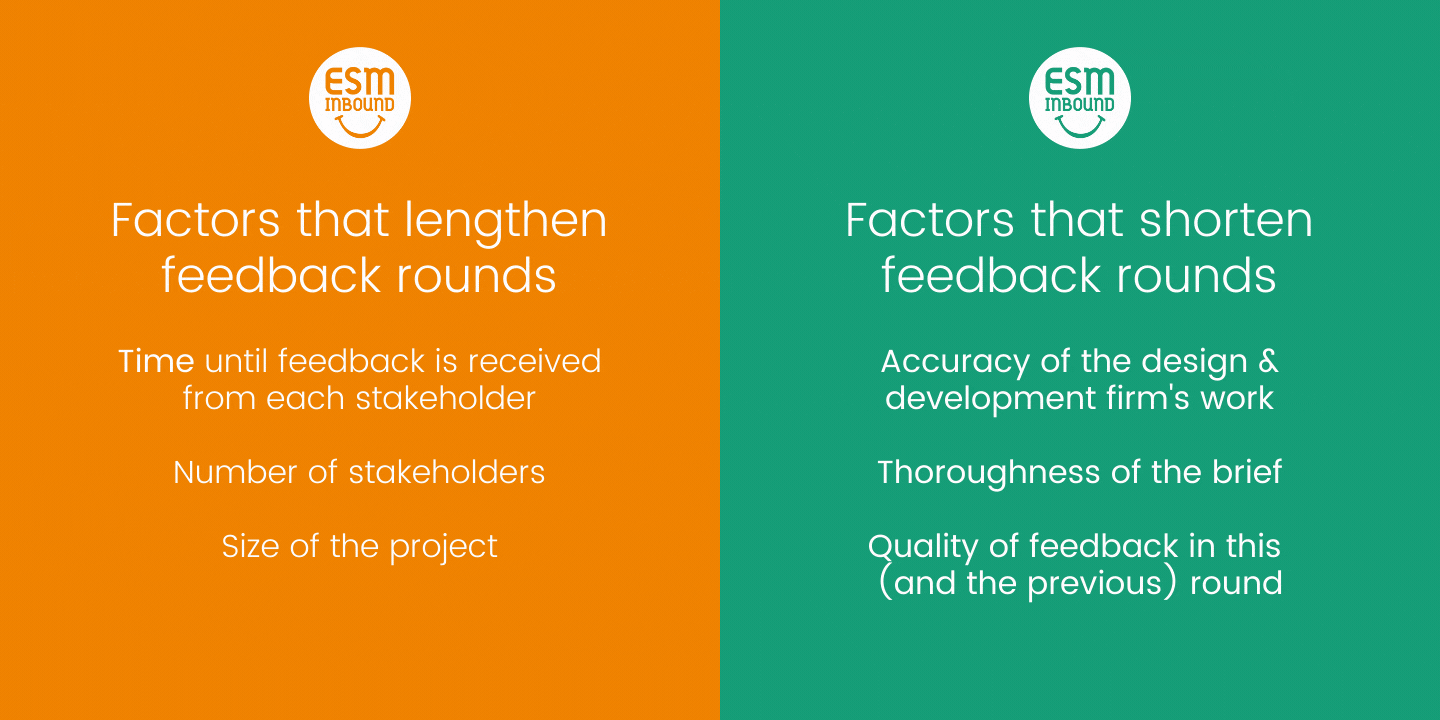As a consultancy, we often find ourselves having to tell clients things they don’t want to hear.
A star salesperson might actually be consistently selling deals that are unprofitable. A product launch plan might not include a mechanism for cross-selling existing customers to the new offering. Your idea for an integration between your software systems isn’t possible because one of the platforms doesn’t have the appropriate API endpoint.
Regardless, we always make it about the project and goals rather than the people involved.
But, very rarely, we have to handle that incredibly difficult conversation where we say “It’s not us, it’s not the project, it’s you”. And there's only one scenario where we find ourselves having to say this… when we are asked about what is most likely to cause a website launch to be delayed.
I’m so sorry to say it, but it’s our professional responsibility. You are the most likely reason that your website will launch late.
Well, not you exactly… your company’s ability to provide the necessary approvals.
A website launch usually includes the following stages:
- goal setting
- user experience design
- copy creation
- design system
- high-fidelity mock-ups of key pages
- theme development
- page development
- quality assurance
- launch.

And, guess what… as the business who will be represented by the finished product, you will insist on approval at the end of each stage. And you’re right to insist on it.
That’s where the delays come in.
A formula for website delays
I’m not an expert mathematician but, once in a while, I find it’s helpful to turn things into an equation. The equation itself doesn’t have to be perfect, but the process of documenting the equation helps to identify the component aspects of a system and, therefore, the areas where you can focus attention to create efficiencies and improve outcomes.
If I were to create a formula for the length of time required for the approval of each stage of a website design, then I would start by identifying the elements that influence the delay. Based on our experience at SpotDev, I would say that they are:
- t = time until feedback is received from each stakeholder
- n = number of stakeholders with approval rights
- s = size of the project
- a = accuracy of the design & development firm’s work compared to the brief
- b = thoroughness of the brief
- q = quality of feedback in this round
- p = quality of feedback in the previous round.
The first thing you’ll notice here is that your website design and development firm only really controls one aspect of the equation — accuracy of our work compared to the brief.
With those elements defined, we can combine them to get a sense of how each one influences the speed of feedback.
( t * (n * s) ) / ( a + b ) + (q * p )

With the formula for the amount of time a feedback round should take established, we can start to look at what you can do to reduce the overall time involved.
Simplifying the equation
If seeing a human process broken down into algebra has left you feeling daunted, then don’t worry. Here’s the really simple way to look at the equation.
To reduce the length of time spent in a revision round, you want to keep the numbers above the line as small as possible and the numbers below the line as large as possible.
That’s because the numbers above the line represent factors that increase the amount of time, while the numbers below the line represent factors that reduce the amount of time.
This means that the factors that can lengthen the revision round are:
- t = time until feedback is received from each stakeholder
- n = number of stakeholders with approval rights
- s = size of the project.
While the factors that can shorten it are:
- a = accuracy of the design & development firm’s work compared to the brief
- b = thoroughness of the brief
- q = quality of feedback in this round
- p = quality of feedback in the previous round.
Let’s take a look at each factor and establish what can be done to optimise it for a speedy website launch.

Factors that can lengthen a revision round
We’ll start by looking at the three factors that can cause a revision round to extend. Remember, your goal with these elements is to keep the number you’re plugging into the equation as low as possible.
Time until feedback is received from each stakeholder
This one seems obvious, but it’s surprisingly common for companies with tight deadlines on a website project to spend large amounts of time before they provide their feedback. This is usually the case when the stakeholders providing the feedback are already busy individuals, balancing multiple priorities. And, in all honesty, that’s most of the time because a website launch tends to have executive-level interest.
And that’s where the key to success with reducing this factor comes into play. Your executive team.
At the very start of the project, you should work with your executive team to gain support for prioritising feedback for a website launch. The most senior person possible should announce and document the fact that providing timely feedback is a top priority for the business.
On top of this, the senior executive should define the amount of time that stakeholders are granted to provide that feedback. Two working days is usually a sensible number, because it grants stakeholders enough time to meaningfully review and consider the resources your website firm provides.
Here’s a sample email that your senior executive could send to stakeholders:
“Dear all,
You have been identified as a stakeholder with revision and feedback rights on our website launch project.
This is a critical role in a project that we have identified as being a priority for the business this quarter. My expectation is that you treat this role seriously and that your feedback is provided in a timely manner.
We have appointed SpotDev as our design and development consultancy for this project. Please provide your feedback in the format that they request at the start of each feedback round.
The maximum amount of time that I am authorising for you to spend on collecting, collating and providing your feedback in the appropriate format is two working days per feedback round. Failure to provide this feedback in that timeframe will mean:
- your feedback is not applied in the project
- you lose the right to provide that same feedback in a future round.
If you fail to provide timely feedback on three occasions, then your role as a stakeholder with revision and feedback rights will be revoked, meaning that you no longer have input into the outcome of the project. I will disappointed if I am forced to take this action.
Best wishes,
Bob Bobness
Senior Executive”
It’s a firm email. It’s one that will likely cause a few raised eyebrows with your colleagues. But it represents the seriousness of the project, and the potential impact your team has on delaying the launch of the website.
A good website design and development firm will reward this level of executive buy-in by providing clear instructions to all stakeholders and making it as easy as possible for people to provide their feedback.
Number of stakeholders with approval rights
While too many cooks may not spoil the broth, having a large number of cooks will certainly mean you’re hungry before lunch is served.
For each stakeholder involved in a project, you are introducing more data points into each revision round. This means that it will take longer for your designers and developers to triage, define and action each item of feedback.
We have often seen companies provide feedback that is contradictory. One stakeholder feels that a ‘buy now’ button should be in the header, while another feels it should be a ‘get a quote’ button. This immediately increases the time spent on the revision round, because your website firm will need to work with you to define which item of feedback is the approved one for the business.
One successful solution we’ve seen many of our clients deploy is to appoint a single stakeholder as having approval rights and a wider (but still small) number of stakeholders as having feedback rights. This means that all feedback goes to that single stakeholder, and they are the person who provides the final feedback to the website firm.
This increases the clarity of the feedback while also reducing the number of stakeholders. Just keep in mind this approach usually implies a small increase on the time required to provide feedback. The wider group of stakeholders will still need two working days and you’ll probably want to give the approval stakeholder an additional day to collate and approve the feedback before sending it to your website firm.
Size of the project
It should go without saying that the larger the project, the longer each round of feedback will take. But what makes a website project larger?
The following elements will usually influence the size of a website project:
- number of pages
- how unique each page layout/design needs to be
- whether or not there is an existing design system in place
- whether or not there needs to be a rebrand as part of the project
- the use of interactive resources on the site
- the clarity of the company’s understanding of the customer journey
- the need for any membership/login sections of the website
- the need for advanced DNS or reverse proxy configuration
- integration with your non-website software systems.
These factors can have a huge impact on the size of a website project — and that impact isn’t always linear. It can take ‘x’ amount of effort to increase the number of templates in a project from three to five but, depending on various factors, it might take ‘3x’ to increase the number of templates from five to eight. An expert website design and development consultancy will be able to advise you on these factors.
To reduce the size of the website project and, therefore, speed up the process of launching a website, many companies choose to start with a launchpad website. This is a new website that meets your business needs, but contains the 20% of features you know will make 80% of the impact you need. Those companies then follow a continuous improvement methodology in order to add more complex features over time.
Factors that can shorten a website launch timeline
Next, we’ll look at the factors that can shorten the time to launching a website. Remember, you want to reach the point where the numbers you're plugging into the equation for these factors are as large as possible.
Accuracy of the design & development firm’s work compared to the brief
This is the area that your chosen design and development team has genuine control over. All the other levers are in your hands. As a result, the only opportunity you have to influence this aspect is while choosing the firm you engage to design and develop your website.
Any vaguely competent website firm will be able to provide you with examples of websites they’ve worked on. Where things typically go wrong is when potential buyers ask themselves: 'Do I want a website that looks like this firm’s portfolio?'. This is entirely the wrong question to ask.
If the website firm is capable of doing great work, then they won’t be concerned about creating a fancy website. They won’t be interested in how beautiful it is, or if it feels slick and modern. These factors should only be relevant if they are part of the brief.
To influence this part of the equation in your favour, you should be looking for a website firm that uses their time with you to learn about your business and your business needs. You should be delighted when they ask you questions such as ‘why are you launching a new website?’, ‘how will you measure the success of this website?’, ‘what are you hoping to achieve by adding this feature?’. This is the information the firm needs in order to ensure your website delivers results for your business.
If, instead, the firm instantly jumps into a slide deck showing you examples of their work and talks about the capabilities of their team, then you should get a little suspicious about the danger of your website being part of a cookie cutter development process.
A great website firm knows that accuracy comes from taking the time to define and understand the brief. That’s the hard part of a website project. The more time you spend on this aspect, the faster every other stage will become.
Thoroughness of the brief
If your website firm should be obsessed with accurately delivering on the brief, then you should ensure that your brief is thorough. You have direct control over this — but you can engage a website consultancy to help.
Your website consultancy should be keen to work with you to help define the brief. As a company, even if you manage multiple brands in multiple territories, you will only be launching a relatively small number of new websites at any one time. Your website firm will be accustomed to delivering new websites on a frequent basis. They will have learnt the hard way that the success of a website relates to how well the brief captures the needs of the business.
Your website consultancy will be able to help you break down key features into use cases, user stories and acceptance criteria. Be wary of a firm who listens to your requirements and simply pulls up ‘an existing template with best practices’ that they say delivers on those requirements. You want to work with a firm that listens, defines and documents your requirements. From there, they will design and develop a website that specifically delivers on those requirements rather than a generalised resource that almost meets everyone’s needs, but precisely meets the needs of no one.
Quality of feedback in this and the previous round
For the purposes of explaining how you can influence these factors in your favour, we’re putting quality of feedback for this and the previous round into a single element. That’s because the same principles will determine how you can succeed at increasing quality.
But why does the previous round of feedback impact the time spent in this round? The truth is that stakeholders sometimes withhold critical feedback from a round of revisions because they don’t want to delay moving to the next stage. They think ‘I won’t share that now because it will delay things, and we can just add it in before launch’.
This is a false economy, and will almost certainly have a negative impact on the time it takes to launch your website. In many cases, it will have a disproportionate impact on the launch time — taking longer to resolve at the end of the project than at the point it was first relevant. This is because your business and your website firm will make choices about the best way to proceed based on the feedback received. As a result, incorporating your feedback later may mean that the simple option for actioning it is no longer available.
A common example of this is where a stakeholder withholds feedback about an interactive resource. They decide they feel it would be better to have an additional input, or to present the information differently. To avoid delaying the project, they withhold the feedback until just before launch. By that time, the database for the resource has been built, the code for how the inputs are processed is written and the integration into your accounting software has been built. All of those systems need to be re-written because of that one change that could have been considered earlier.
Even if you think that an item of feedback is small and it won’t matter until later, it’s important that you provide the information as soon as possible. A high-quality design and development firm will be looking for the best-optimised approach to your website so that it’s fast and efficient. Give them the ability to do this for you by providing your input at the earliest stage possible.
On top of that, it’s important that your feedback is precise. It’s not unusual to get feedback such as:
- “This doesn’t really work for me”
- “I don’t like this”
- “This doesn’t look like us”.
For the purposes of advancing the project, this feedback is clearly important — but it’s entirely useless. Your firm will have to reach out to you and dig into the details to understand the ‘why’ behind your feedback. Reduce the time it takes to deliver the right result by being precise in the first place. If you find yourself saying “I’m not sure why”, then it’s usually a sign that you need to take a little more time to articulate your thoughts.
Who would we trust to be your website design and development firm?
SpotDev is a website design and development consultancy. We’ve built dozens of websites that delight our clients and their audiences. We are entirely confident that we can work with you to build a superb website that meets your exact business needs. Even better, our Diagnostic Engagement service can help you to create a world class brief that ensures the website project goes quickly and smoothly through each round of revisions.
If, however, you feel the need to explore additional website firms, then you can read our list of alternative firms in this article.
You can book a call with an SpotDev consultant to discuss your website project using this link.
Stay Updated with Our Latest Insights
Get expert HubSpot tips and integration strategies delivered to your inbox.




